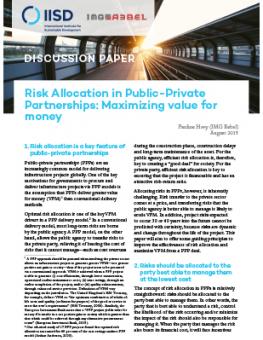
Risk Allocation in Public-Private Partnerships: Maximizing value for money
Optimal risk allocation is one of the key value for money (VFM) drivers in a public-private partnership (PPP) delivery model. In a conventional delivery model, most long-term risks are borne by the public agency.
A PPP model, on the other hand, allows the public agency to transfer risks to the private party, relieving it of bearing the cost of risks that it cannot manage—such as cost overruns during the construction phase, construction delays and long-term maintenance of the asset. For the public agency, efficient risk allocation is, therefore, key to creating a “good deal” for society. For the private party, efficient risk allocation is key to ensuring that the project is financeable and has an attractive risk-return ratio. Allocating risks in PPPs, however, is inherently challenging. Risk transfer to the private sector comes at a price, and transferring risks that the public agency is better able to manage is likely to erode VFM. In addition, project risks expected to occur 30 or 40 years into the future cannot be predicted with certainty, because risks are dynamic and change throughout the life of the project. This paper will aim to offer some guiding principles to improve the effectiveness of risk allocation and maximize VFM from a PPP deal.
This paper was funded by the Danish International Development Agency (DANIDA).
You might also be interested in
Monitoring Progress in Green Public Procurement
This report outlines the importance of monitoring progress in green public procurement (GPP) and highlights various methodologies, challenges, and recommendations.
Gender Equality at the Heart of Recovery: Advocating for Gender-Responsive Procurement in Ukraine
Ukraine is already preparing for reconstruction, which will cost an estimated USD 411 billion and take at least 10 years. The integration of gender considerations into public procurement processes could generate greater inclusivity in a rebuilt Ukraine.
A Sustainable Asset Valuation of Non-Motorized Transport in Coimbatore, India
A Sustainable Asset Valuation (SAVi) of the economic, social, and environmental benefits of a non-motorized transport (NMT) network in Coimbatore, India.
FAQ: Legal Considerations When Using the CO2 Performance Ladder in Public Procurement
This report answers frequently asked questions about the legal aspects of using the CO2 Performance Ladder as a green public procurement tool.